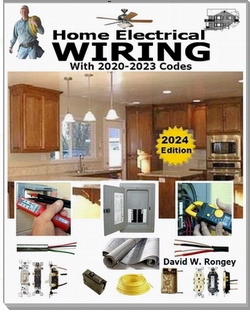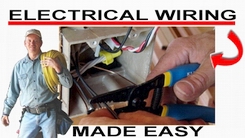» Need Electrical Help? Ask the Electrician
Why do my CFL Lights Burn Out Fast

|
By Dave Rongey
© By: Dave Rongey |
Why Your CFL Lights Burn Out Fast
Why CFL Lights Burn Out Fast.
I manage a retail store with both fluorescent and track lighting.
I replaced all the track lighting with CFL floods 6 months ago and 90% have now burned out. Do you know why?
I did notice many of the lights would flicker for a few days before they would go.
Thanks Doug
Hi Doug - Great Electrical Repair Question!
This is going to be a personal favorite of mine because I see this happen way too often.
First - lets get a little more information.
I'd like to know the specifications of the fixtures, as much as possible, or at least, what were the original specified lamps, and what you replaced them with - make/mfg and specs of the CFL's.
I know where your store is located and there shouldn't be a utility voltage problem in this area.
Was this CFL exchange a result of a Energy Rebate Program, i'm just curious.
We need to make sure that the track lights are not controlled by any type of dimmer switch - please verify this.
Did the track lights have any problems before with lamps burning out? Sometimes we have had a problems with vibrations from heating or cooling units which would cause filaments to wear out prematurely. Approximately how many hours per day do these fixtures operate?
I can appreciate your desire to reduce energy and maintain adequate illumination for the store merchandise, lets see if we can pin point the problem. Please make these checks and let me know what you find.
All the best,
Dave
Hi Dave,
Thanks for the fast response!
The original lights were normal flood lamps.
No, my change to CFL's had nothing to do with SMUD, the local utulity company.
Yes, the track lights are on dimmer switches. And yes, there seems to be significant vibration from the heating/cooling system on the roof.
The lights are on 10 hours a day. So, it appears my system failed all your questions. Is there any hope?
Thank you so much!
Doug.
Hi Doug,
The first thing you need to do is remove the dimmer switch from the power feed to the track lights or anything that is providing power to the CFL lamps. The most common CFL should be on a straight 120 volt line with no dimming control, unless it specifies that you can, and in that case the mfg will specify the proper dimmer.
Your CFL's will tell you how many hours they should last, but this is under ideal conditions. One thing that reduces the life is several on/off switching. However with burning these CFL's 10 hours a day, with straight 120 volts, and no dimmer control should be the ideal environment.
The vibrations may be a factor, but more of the old incandescent floods where the filaments are longer, not so much with CFL's. When the HVAC units run, do you see a momentary surge in your light output? If so you may need to have the circuit that feeds your lighting switched to another buss back at the panel. It would depend on the circuit serving the HVAC unit(s).
If the HVAC units are 3-phase circuits, then switching the lighting circuit to another buss would not help, but a good line conditioner would - it would decrease line surges. Having said all this - bottom line from my end here is that if you remove the controlling dimmer off of the CFL line, you'll eliminate your problem.
Pass this on to corporate and let them know how your reduction is working out, I'm sure they would love to know. Better yet - if I can be of assistance, pass this info to corporate, and I can help advise them directly.
We have provided lighting solutions to retail stores which have produced great savings and ideal merchandise illumination.
Let me know how this works out. I will keep you informed on my results.
Thanks Again Doug.
The Safest Way to Test Electrical Devices and Identify Electric Wires!The Non-Contact Electrical TesterThis is a testing tool that I have had in my personal electrical tool pouch for years, and is the first test tool I grab to help identify electrical wiring. It is a Non-contact tester that I use to easily Detect Voltage in Cables, Cords, Circuit Breakers, Lighting Fixtures, Switches, Outlets and Wires. Simply insert the end of the tester into an outlet, lamp socket, or hold the end of the tester against the wire you wish to test. Very handy and easy to use.
The Quickest Way to Check for Faulty Electrical Wiring!The Plug-In Outlet TesterThis is the first tool I grab to troubleshoot a problem with outlet circuit wiring. This popular tester is also used by most inspectors to test for power and check the polarity of circuit wiring. It detects probable improper wiring conditions in standard 110-125 VAC outlets Provides 6 probable wiring conditions that are quick and easy to read for ultimate efficiency Lights indicate if wiring is correct and indicator light chart is included Tests standard 3-wire outlets UL Listed Light indicates if wiring is incorrect Very handy and easy to use.
Strip Off Wire Insulation without Nicking and Damaging the Electric Wire!The Wire Stripper and Wire CutterMy absolute favorite wire stripping tool that I have had in my personal electrical tool pouch for years, and this is the tool I use to safely strip electrical wires. This handy tool has multiple uses: The wire gauges are shown on the side of the tool so you know which slot to use for stripping insulation. The end of the tool can be used to grip and bend wire which is handy for attaching wire onto the screw terminals of switches and outlets.. The wire stripper will work on both solid and stranded wire. This tool is Very Handy and Easy to Use. |
||
Residential Electrical Parts and AccessoriesLight Switches 120volt Outlets Circuit Breakers Electrician Tools Voltage Testers |














